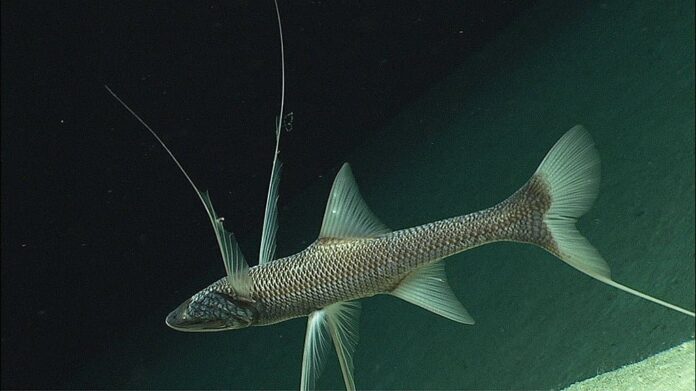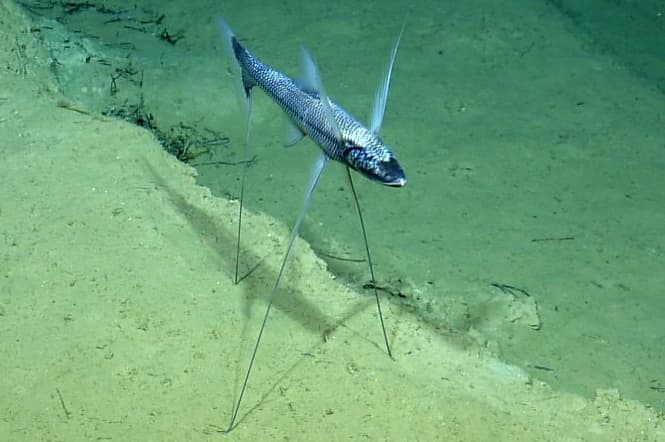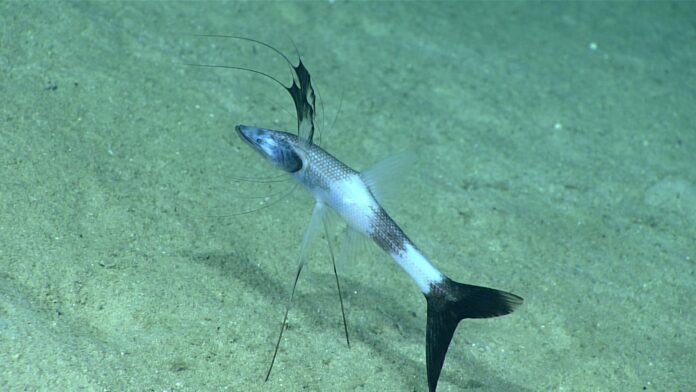The deeper the ocean, the weirder the creatures get; and here’s a good example of one. Those tripod-like fins are not the only peculiar things about tripod fish, there are more. While not looking bizarre like other deep sea creatures, this one is still quite fascinating to look at. We should learn a bit more about the tripod fish together, and let’s dive into that right now.
1Appearance

A tripod fish has the body of a normal fish that is 30 to 37 centimeters long from head to tail. Its coloration ranges from bronze to pale with gray on the head, belly, and along the lower back. Tripod fish are eyeless because they live in complete darkness, and that is why their fins are important. The fish has long bony rays that stick out below its tail fin and both pelvic fins.
Speaking of fins, it has long fins that can be longer than 1 meter. These fins are the main features of tripod fish, the feature that earns the fish its name. Simply because a tripod fish can use these 3 fins to stand on the bottom of the ocean while hunting. A fish that can stand? This is exactly why this fish species is very fascinating. When not standing, the fins are flexible and they move naturally as the fish swims.
2Behavior
The tripod fish are mainly solitary and live alone close to the ocean floor throughout their adult life. They usually live above the substrate where there are more currents which benefits their hunting. When hunting, a tripod fish faces in the direction of water movement, stay still, and wait for food to arrive. This hunting method requires very little energy which is an essential adaptation for predators that live under extreme pressure environments. And as solitary creatures, they are synchronous hermaphrodites so they are able to produce both sperm and eggs. While being able to breed on their own, two fish will breed if they meet.
3Feeding & Habitats

This fish species does not have special visual adaptations to help it find food in low-light environments at all. So it uses its tactile and mechanosensory cues to identify food when it perches with its long rays on the ocean floor. With this special ability to feel the vibrations from prey, it doesn’t need to see the food to catch it at all. Its long feathery pectoral fins alert it when they sense food and will act as hands to capture and direct the food towards its mouth. A tripod fish’s mouth is at just the right height to catch small crustaceans, shrimps, and tiny fish that swim by.
Tripod fish have a wide range across the Atlantic, Indian, and Pacific oceans, living in the benthic zone. The benthic zone is the ecological region at the lowest level of a body of water such as lake, ocean, or stream. In the oceans, the benthic region begins at the shoreline and extends downward along the surface of the continental shelf out to sea. Tripod fish and other sea creatures that live in this zone can tolerate cool temperatures and low oxygen levels.
Related Post: Things You Don’t Know About Crocodile Fish





